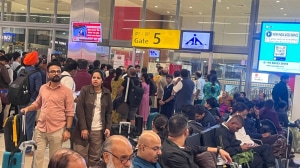Stay updated with the latest - Click here to follow us on Instagram
Fear, rumours on social media bring people out on streets
Unlike cyclones, storms, and even tsunami, these give absolutely no warning before striking.
 People fled buildings as tremors were felt in Gurgaon. (Source: Manoj Kumar)
People fled buildings as tremors were felt in Gurgaon. (Source: Manoj Kumar)
As night fell on Patna’s Gandhi Maidan, the historic grounds in the heart of the city swarmed with thousands of people, drawn out of their homes by swirling rumours of a bigger, more devastating earthquake. It would measure 15 on the Richter scale, predicted some messages circulating on social media; some tweets also put out the time when apocalypse might strike: “in 2 hours”, at “11 pm”.
In Lucknow, a “severe warning” circulated on WhatsApp that a “stronger” earthquake would hit at “3 pm”.
As if the Nepal quake and the series of aftershocks did not create enough panic in north Indian cities, rumours spread through social media added to the fear of another possible earthquake .
[related-post]
Earthquakes, however, cannot be predicted. Unlike cyclones, storms, and even tsunami, these give absolutely no warning before striking. Scientists across the world have been researching for years to identify signals of an oncoming seismic wave, but have been unsuccessful so far.
“There is absolutely no method or technology that can predict earthquakes as of now. So, there is no way to say when or where the next earthquake would strike, or how strong it would be,” Harsh K Gupta, former director of the Hyderabad-based National Geophysical Research Institute, said.
Gupta, who is also a former member of the National Disaster Management Authority, said such talk was not just “unscientific” but also “mischievous”.
“It amounts to predicting earthquakes which cannot be done with our present knowledge,” he said.
Scientists in India are also engaged in a research project to detect the predictors of an earthquake. A site in earthquake-prone Koyna in Maharashtra is being used as a laboratory to carry out experiments to understand the nature and origin of earthquakes. Scientists say they are at least a decade away from finding any such indicator.







